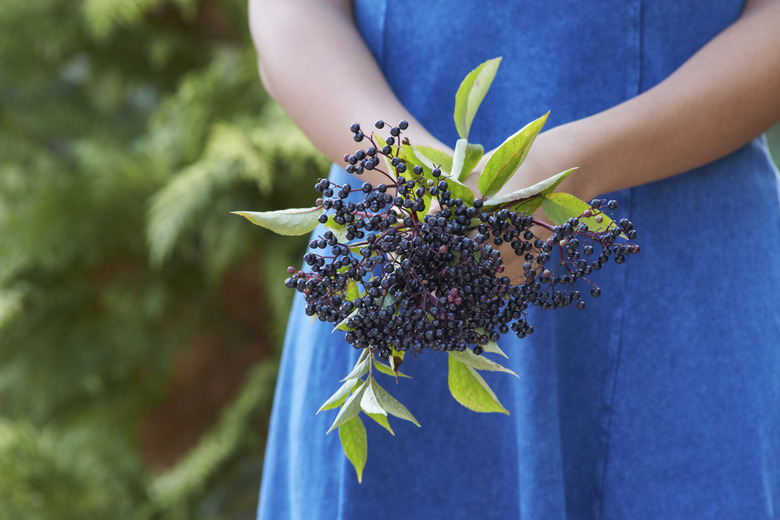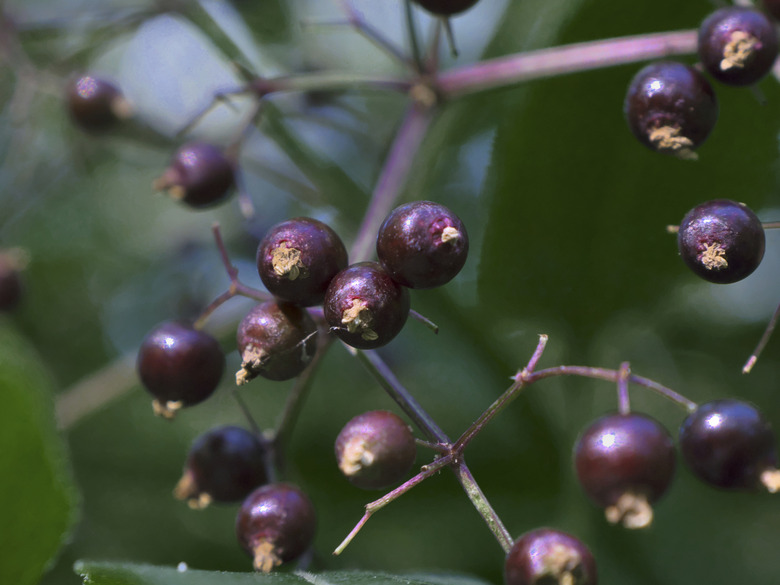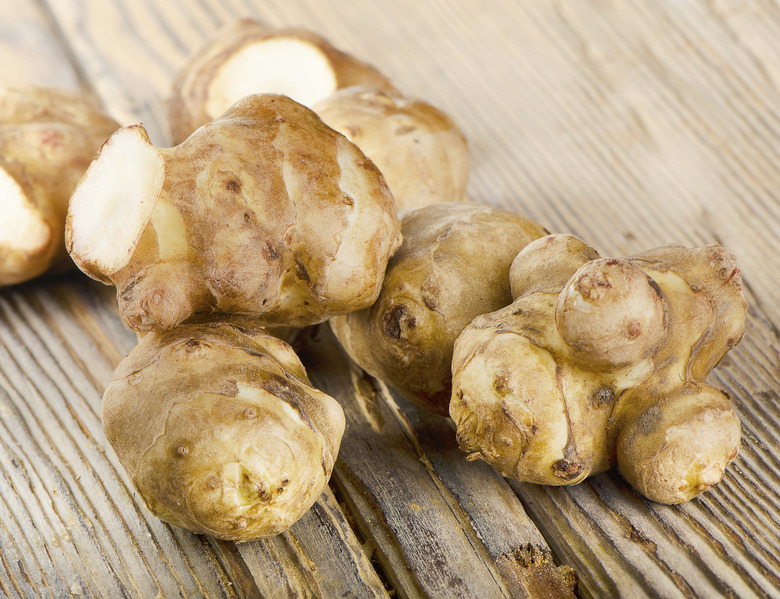Edible Wild Plants In Indiana
Indiana experiences a mid-continental climate with cold winters and warm summers. Rainfall averages about 45 inches in the south-central area to about 37 inches in the north, and snowfall occurs for six months, averaging from 20 inches to more than 100 inches in the north near Lake Michigan. Indiana contains U.S. Department of Agriculture plant hardiness zones 5a through 6b. Before settlement by Europeans, most of Indiana was hardwood forest with some grassland. It's now mostly second-growth forest, urban areas and croplands. Edible wild plants live in woodlands, pastures and disturbed areas throughout the state.
Nut-Bearing Trees
Some large forest trees furnish edible nuts important as food for many kinds of wildlife. Shagbark hickory (Carya ovate), hardy in USDA zones 4 through 8, is slow-growing to 98 feet tall and 49 feet wide, bearing numerous hard-shelled, sweet-kerneled nuts in fall. Some thinner-shelled cultivars exist. They're suitable as shade or specimen trees. Look for wild trees along moist river bottoms or upland slopes. Also a substantial but slightly shorter tree, butternut (Juglans cinerea), hardy in USDA zones 3 through 7, grows 82 feet tall and 65 feet wide. It has sweet, oily-tasting kernels that are hard to extract from the nut. Once the kernel is exposed, it doesn't keep for long. Butternut's native habitat is in moist woods and on river terraces.
- Indiana experiences a mid-continental climate with cold winters and warm summers.
- Also a substantial but slightly shorter tree, butternut (Juglans cinerea), hardy in USDA zones 3 through 7, grows 82 feet tall and 65 feet wide.
Shrubs with Edible Fruit
Multistemmed large shrubs offer summer fruits for people and wildlife. Blackhaw viburnum (Viburnum prunifolium), hardy in USDA zones 3 through 9, produces bluish-black fruit edible when raw or used to make jellies and preserves. In spring, small, white, fragrant flowers occur at branch ends in flat-topped clusters, making this an ornamental garden plant. The 12- to 15-feet-tall shrub inhabits streamsides and thickets in nature, and works well as a garden hedge. A summer-ripening fruit, elderberry looks delicious shouldn't be eaten raw. The plant (Sambucus canadensis), hardy in USDA zones 3 through 11, produces fruits that are black and glossy, but they have alkaloid compounds that give an unpleasant taste to raw berries, although birds relish them. Cook the harvested fruits for about 15 minutes and use the juice for jelly or pies. Growing wild along wood edges and streams, 10- to 15-foot tall elderberries have showy white flower clusters in spring and need yearly pruning to keep the growth under control.
- Multistemmed large shrubs offer summer fruits for people and wildlife.
- The plant (Sambucus canadensis), hardy in USDA zones 3 through 11, produces fruits that are black and glossy, but they have alkaloid compounds that give an unpleasant taste to raw berries, although birds relish them.
Wild Berries
Two types of delicious wild berries occur in Indiana. Offering abundant berries that blacken when ripe, black raspberry (Rubus occidentalis, hardy in USDA zones 3 through 7) is a sprawling, thorny bramble with arched canes that can grow to 9 feet long. Eat the fruit raw or cook it into pies and preserves. Showy white flowers and berries occur on 2-year-old wood. For a berry plant that is easy to pick, Virginia strawberry (Fragaria virginiana, hardy in USDA zones 3 through 7) bears small but sweet and tasty red fruits in early summer. Plants are about 1 foot tall and grow in woodland margins or in open fields. They thrive in well-drained, moist soil.
- Two types of delicious wild berries occur in Indiana.
- Showy white flowers and berries occur on 2-year-old wood.
Roots and Vines
A prairie species with showy, yellow flowers and that bears edible tubers on its roots, Jerusalem artichoke (Helianthus tuberosa, hardy in USDA zones 3 through 9) is a branching, perennial sunflower. The tubers are good raw or cooked. Each plant can yield 2 to 5 pounds of tubers. For a vine with showy, complex purple flowers and oval, edible fruits, consider purple passion flower (Passiflora incarnata, hardy in USDA zones 5 through 9). Blooming all summer long, the 6- to 8-foot vines grow back each year from perennial roots. The soft fruits have a sweet pulp studded with small, black seeds and are yellow when ripe. Eat them raw or use them for jelly.
- A prairie species with showy, yellow flowers and that bears edible tubers on its roots, Jerusalem artichoke (Helianthus tuberosa, hardy in USDA zones 3 through 9) is a branching, perennial sunflower.
- For a vine with showy, complex purple flowers and oval, edible fruits, consider purple passion flower (Passiflora incarnata, hardy in USDA zones 5 through 9).
References
- Encyclopaedia Brittanica: Indiana
- U.S. Department of Agriculture Agricultural Research Service: USDA Plant Hardiness Zone Map
- Plants for the Future: Carya Ovata – (Mill.) K. Koch.
- Plants for the Future: Juglans Cinerea – L.
- Missouri Botanical Garden: Viburnum Prunifolium
- Floridata: Sambucus Canadensis
- Plants for a Future: Rubus Occidentalis – L.
- Plants for a Future: Fragaria Virginiana – Duchesne.
- Floridata: Helianthus Tuberosus
- Missouri Botanical Garden: Passiflora Incarnata




